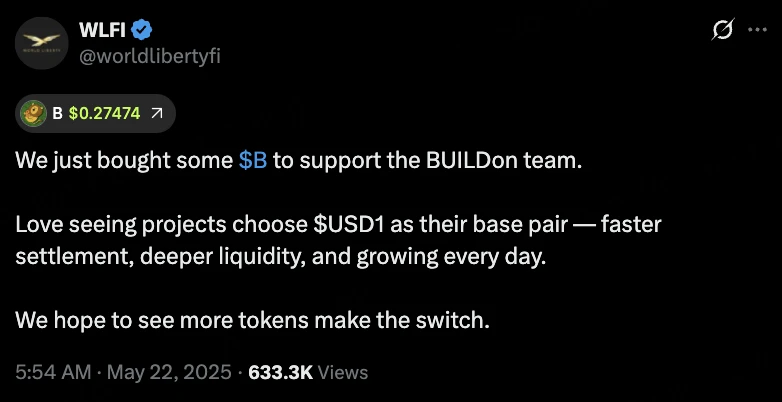Preface
Since the collapse of TerraUSD (UST) in 2022, the market share of algorithmic stablecoins has continued to decline. UST, as an algorithmic stablecoin, is not backed by any fiat currency or assets, relying solely on algorithms to maintain its peg to the US dollar. Once confidence collapses and the mechanism fails, the market can experience a chain reaction. In contrast, fiat-backed stablecoins (such as USDT, USDC, USD1) that use high liquidity assets like US dollars and US Treasury bonds as reserves have gradually become the market mainstream. However, even these stablecoins are still under scrutiny regarding their compliance and transparency. In response to this challenge, the United States has recently accelerated the advancement of the GENIUS Act, aimed at establishing a comprehensive regulatory framework for the stablecoin market.
I. GENIUS Stablecoin Act
Importance of the GENIUS Act to the Crypto Market
The core of the GENIUS Act includes key elements such as issuance qualification restrictions, reserve requirements, compliance obligations, user protection, and international applicability. The Act clearly stipulates that issuing institutions must fully back their issued stablecoins with equivalent high liquidity assets, ensuring that users can redeem at any time. Additionally, to protect the interests of token holders, if the issuing institution goes bankrupt, its assets should be prioritized for repaying user funds. Furthermore, issuers must strictly comply with anti-money laundering (AML) and counter-terrorism financing (CFT) obligations to prevent stablecoins from being used for illegal purposes. Overall, the GENIUS Act can strengthen the regulation of stablecoins and protect user rights; however, in the short term, the Act raises the threshold for stablecoin issuers, requiring existing issuers to change their asset reserve structures and information disclosure mechanisms, which may incur high costs and operational difficulties.
Core Provisions of the Act
1. Licensing and Regulatory Framework
The Act stipulates that only three types of entities are allowed to issue payment stablecoins: first, subsidiaries of banks or credit unions; second, non-bank financial institutions approved by federal regulators (such as those regulated by the OCC); and third, state-level issuers that meet federal "substantive equivalence" standards. The regulation adopts a "dual system": issuers with a market capitalization exceeding $10 billion must accept federal regulation; smaller issuers may be regulated by the state but must meet federal basic requirements.
2. Reserve and Asset Segregation Requirements
All stablecoins must implement 100% reserve support, using only high liquidity assets such as cash, demand deposits, short-term US Treasury bonds (≤93 days), short-term repurchase agreements (≤7 days, subject to central bank regulation), and central bank reserves. Customer assets must be strictly segregated from operating funds, prohibited from being re-pledged, and can only be temporarily pledged for short-term liquidity purposes.
3. Transparency, Auditing, and Accountability Mechanisms
Issuers must disclose the composition of reserve assets monthly and undergo audits by registered accounting firms. For issuers with a market capitalization exceeding $50 billion, auditing and compliance requirements are stricter. The CEO and CFO of the issuing institution must sign monthly compliance certifications, and false statements will incur criminal liability. Regulatory agencies will also establish standards for capital, liquidity, and risk management.
4. Anti-Money Laundering and National Security Compliance
Stablecoin issuers are considered financial institutions under the Bank Secrecy Act and must establish AML and sanctions compliance systems, including transaction monitoring, risk assessments, and suspicious activity reporting. Issuers must also retain transaction records for regulatory review.
5. Restrictions on Foreign Issuers and Large Tech Companies
Foreign stablecoin issuers that do not comply with US equivalent regulatory standards will be prohibited from providing services in the US. Large tech companies (such as Meta and Amazon) that engage in stablecoin issuance must meet strict financial compliance, user privacy, and fair competition requirements to prevent monopolies and systemic risks.
6. Consumer Protection and Bankruptcy Priority Rights
Stablecoin users have priority repayment rights in the event of the issuing institution's bankruptcy. To prevent conflicts of interest, the Act prohibits members of Congress and senior executive officials from participating in stablecoin issuance during their terms.
7. Legal Classification and Regulatory Boundaries Clarified
The Act clearly states that payment stablecoins do not fall under the category of securities or commodities, thereby excluding the regulatory authority of the SEC and CFTC, defining the legal boundaries of stablecoins and avoiding overlapping regulation.
Progress of the Act
As of May 22, the stablecoin GENIUS Act passed the debate motion with 69 votes in favor and 31 against, entering the amendment process. With the rapid advancement of stablecoin legislation in both the House and Senate, a rare bipartisan consensus has been reached on the regulation of crypto assets, and the Act is expected to complete the legislative process by Q4 2024.
II. Introduction to USD1
Background of USD1
USD1 is a US dollar stablecoin launched in March 2025 by World Liberty Financial Inc. (WLFI), a DeFi platform controlled by members of former President Trump's family. The goal is to peg each USD1 to the US dollar at a 1:1 ratio, fully backed by US short-term Treasury bonds, dollar deposits, and cash equivalents. The project emphasizes compliance and transparency, with reserve assets regularly audited by a third-party accounting firm and held in custody by digital asset custodian giant BitGo. Zach Witkoff, one of the co-founders of WLFI, and Eric Trump, son of Trump, are key figures in the project, with the latter also serving as the head of WLFI.
Current Status of USD1
Recently, as the price of BTC broke historical highs and the popularity of USD1 increased, its ecological cooperation projects have also gained market attention. The prices of tokens from several partners, including Buildon, Lista DAO, StakeStone, Haedal, and Cookie, have surged significantly, driving market enthusiasm for the "WLFI+USD1" concept. As of mid-May 2025, the market capitalization of the USD1 stablecoin has surpassed $2.1 billion, making it the seventh-largest stablecoin, rapidly expanding since its launch in March, deployed on Ethereum, BNB Chain, and recently launched on the Tron network. However, according to WLFI's official description, USD1 is primarily targeted at institutional users, and its most significant progress in practical applications is being selected by the Abu Dhabi investment firm MGX as the official stablecoin for a $2 billion investment in Binance, becoming its first major real-world application case.
USD1 Ecological Cooperation Projects
1. BUILDon
BUILDon is a MEME related to the mascot of BSC's construction culture. On May 17, the project officially announced the addition of a USD1 trading pair and has since continued to interact with WLFI on Twitter. On May 22, WLFI announced the purchase of BUILDon token B, subsequently driving its price up over 450%.

2. StakeStone
On May 9, StakeStone announced a partnership with WLFI to provide USD1 users with a comprehensive liquidity infrastructure and cross-chain staking yields. On May 22, with Binance listing USD1, the price of STO rose over 20% in a single day.

3. Lista
On May 7, Lista officially announced a strategic partnership with WLFI, stating that the Lista DAO ecosystem would add USD1 to its treasury and also plans to add USD1/lisUSD LP and use USD1 as CDP collateral. On May 22, with Binance announcing the listing of USD1, Lista's price rose 37.9% in a single day.

In other cooperative aspects, USD1 is currently collaborating with multiple DeFi protocols such as Venus Protocol, Aster, Meson Finance, and Falcon Finance, supporting USD1 for trading, collateral, or liquidity assets. In terms of custody and liquidity services, BitGo is responsible for holding reserve assets, while BitGo Prime provides institutional-level liquidity and trading services. DWF Labs has deployed multiple DeFi liquidity pools for USD1 and subscribed to WLFI tokens with $25 million. Additionally, in the realm of crypto wallets and consumer scenarios, TokenPocket, HOT Wallet, Pundi X, and Umy have integrated USD1 for payments, hotel bookings, and merchant settlements in various Web3 scenarios.
USD1 Compared to Other Competitors
In terms of mechanism design, USD1 does not significantly differ from other mainstream stablecoins like USDT and USDC, all adopting a 1:1 dollar asset reserve model, primarily supported by US Treasury bonds, cash, and other high liquidity assets, and ensuring transparency and compliance through third-party custody and regular audits. However, USD1's unique advantage lies in the strong political brand effect behind it. The USD1 issued by WLFI, led by the Trump family, has not only developed rapidly in its early stages but has also been used in the $2 billion investment transaction by the Abu Dhabi investment firm MGX in Binance. This rapid growth is largely attributed to the public influence and political resources of the Trump family, enhancing market confidence in its compliance and credibility. However, it is worth noting that the $TRUMP coin previously launched by Trump experienced significant price volatility, raising market concerns about its stability and long-term value. Such volatility may affect investor confidence in USD1, especially considering the potential impact of political factors on the crypto asset market.
III. Future Development
The GENIUS Act is not only a regulatory framework for stablecoins but also a strategic initiative by the United States to promote the issuance of compliant stablecoins pegged to the US dollar, attract global capital towards US Treasury bonds, and restrict foreign issuers, thereby comprehensively strengthening the international dominance of the digital dollar. These measures help prevent the recurrence of incidents similar to TerraUSD, enhancing the overall security and stability of the crypto market. In this context, stablecoin projects with strong compliance are expected to gain greater market recognition in the future. For example, stablecoin projects like USD1, which have strong backing, are likely to occupy a more important position in the future crypto ecosystem as subsequent legislation progresses.
Risk Warning:
The information provided is for reference only and should not be considered as advice to buy, sell, or hold any financial assets. All information is provided in good faith. However, we make no express or implied representations or warranties regarding the accuracy, adequacy, effectiveness, reliability, availability, or completeness of such information.
All cryptocurrency investments (including returns) are inherently highly speculative and involve significant risk of loss. Past, hypothetical, or simulated performance does not necessarily represent future results. The value of digital currencies may rise or fall, and there are significant risks associated with buying, selling, holding, or trading digital currencies. You should carefully consider whether trading or holding digital currencies is suitable for you based on your individual investment goals, financial situation, and risk tolerance. BitMart does not provide any investment, legal, or tax advice.
免责声明:本文章仅代表作者个人观点,不代表本平台的立场和观点。本文章仅供信息分享,不构成对任何人的任何投资建议。用户与作者之间的任何争议,与本平台无关。如网页中刊载的文章或图片涉及侵权,请提供相关的权利证明和身份证明发送邮件到support@aicoin.com,本平台相关工作人员将会进行核查。




